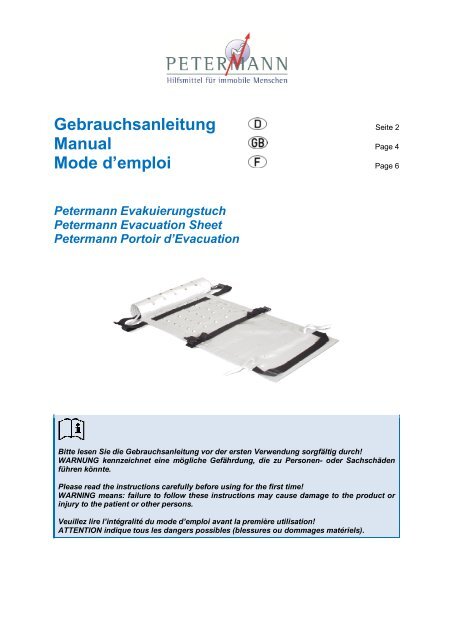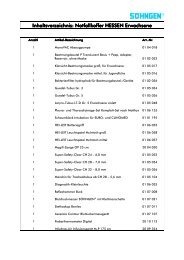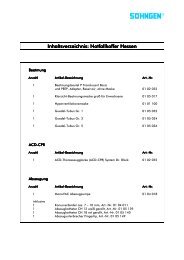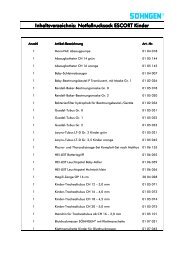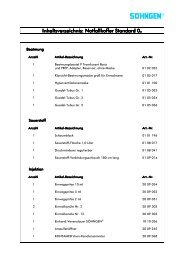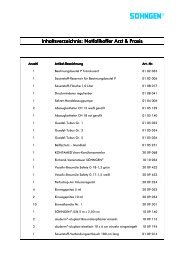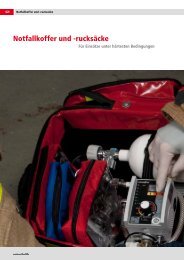Gebrauchsanleitung Manual Mode d'emploi - Hallo-Medi
Gebrauchsanleitung Manual Mode d'emploi - Hallo-Medi
Gebrauchsanleitung Manual Mode d'emploi - Hallo-Medi
You also want an ePaper? Increase the reach of your titles
YUMPU automatically turns print PDFs into web optimized ePapers that Google loves.
<strong>Gebrauchsanleitung</strong> Seite 2<br />
<strong>Manual</strong> Page 4<br />
<strong>Mode</strong> d’emploi Page 6<br />
Petermann Evakuierungstuch<br />
Petermann Evacuation Sheet<br />
Petermann Portoir d’Evacuation<br />
Bitte lesen Sie die <strong>Gebrauchsanleitung</strong> vor der ersten Verwendung sorgfältig durch!<br />
WARNUNG kennzeichnet eine mögliche Gefährdung, die zu Personen- oder Sachschäden<br />
führen könnte.<br />
Please read the instructions carefully before using for the first time!<br />
WARNING means: failure to follow these instructions may cause damage to the product or<br />
injury to the patient or other persons.<br />
Veuillez lire l’intégralité du mode d’emploi avant la première utilisation!<br />
ATTENTION indique tous les dangers possibles (blessures ou dommages matériels).
1. Technische Daten und Lieferumfang<br />
Bestell-Nr.: PM-EVA-7051-H<br />
Farbe:<br />
weiß<br />
für Bettengröße: Länge 190 bis 205 cm<br />
Breite 80 bis 100 cm<br />
Material:<br />
PVC-beschichtetes<br />
Polyestergewebe, komplett<br />
perforiert, latexfrei<br />
TÜV geprüft nach DIN EN 1865<br />
Lieferumfang:<br />
Evakuierungstuch inkl. Signalfahne und vier<br />
Fixierungseckschlaufen<br />
<strong>Gebrauchsanleitung</strong><br />
Optional: ventilierende Netzgewebe-Einlage für<br />
Spiralfeder-Lattenrost (Bestell-Nr. PM-EVA-7058)<br />
Made in Germany<br />
max.<br />
150 kg<br />
2. Anwendung / Platzierung<br />
Das Evakuierungstuch wurde ausschließlich für den Einsatz in Pflegebetten zur schnellen, sicheren und<br />
schonenden Evakuierung von nicht gehfähigen Menschen entwickelt.<br />
Legen Sie das Evakuierungstuch in die Mitte des Bettes direkt auf den Bettrahmen. Die eingeschlagenen Gurte<br />
mit Gurtschnallen sind mit jeweils einem Gummiband positioniert. Die Stecker der Gurtschnallen sollen an der<br />
begehbaren Seite des Bettes vorliegen. Die Matratze wird auf das Evakuierungstuch gelegt. Die Gurtschnallen<br />
sollten von der Matratze überdeckt sein. Kennzeichnen Sie das Bett mit dem eingelegten Evakuierungstuch,<br />
indem Sie die an einer Steckschnalle befindliche Signalfahne sichtbar lassen.<br />
Option:<br />
1. Falls erforderlich, können Sie das Evakuierungstuch mit den vier beiliegenden<br />
Fixierungseckschlaufen an der Matratze befestigen. Hierzu ziehen Sie jeweils eine<br />
Fixierungsschlaufe durch die Perforationsöffnung, die sich an der äußersten Ecke des<br />
Evakuierungstuchs befindet. Diese lassen sich nun über die jeweilige Ecke der<br />
Matratze ziehen, so dass anschließend das Evakuierungstuch auf der Matratze fixiert<br />
ist.<br />
2. Bei Lattenrosten mit Spiralfedersystem ist die Verwendung der Netzgewebe-Einlage (Bestell-Nr.<br />
PM-EVA-7058) zwingend erforderlich.<br />
03/2011 2 / 8
3. Rettungssituation<br />
Stellen Sie sich an die begehbare Seite vor das Bett. Wenn möglich, bringen Sie Kopf- und Fußteil des<br />
Bettrahmens in die Liegeposition. Betten Sie den Liegenden von beiden Seiten schützend mit den Bettdecken<br />
ein. Ziehen Sie die zwei Gurtstecker mit dem Gurtband aus der Positionierung. Knien Sie sich auf das Bett und<br />
ziehen die gegenüber liegenden Gurtschnallen aus der Positionierung. Stellen Sie über die Querseite der<br />
Matratze eine Steckverbindung der Gurte her. Ziehen Sie nun die Gurte nacheinander an den losen Enden an<br />
und anschließend so fest wie möglich zu. Für die liegende Person entsteht so eine schützende U-Form der<br />
Matratze. Die Matratze ist nun auf dem Evakuierungstuch sicher fixiert. An den groß dimensionierten Gurtgriffen<br />
am Fuß- oder Kopfende ziehen Sie das Evakuierungstuch mit der fest fixierten Matratze aus dem Bett über den<br />
Fußboden, durch die Tür über Treppen hinunter in eine sichere Zone. Wenn die Rettungssituation es erfordert,<br />
kurzfristig das Evakuierungstuch zu tragen oder ein Hindernis nur mit Hilfe von Helfern zu überwinden, benutzen<br />
Sie die Gurtgriffe am Kopf- und Fußende für das seitliche Tragen. Zusätzlich befinden sich an der seitlichen Mitte<br />
der Matte Trageschlaufen. So können bis zu sechs Helfer das Evakuierungstuch tragen.<br />
4. Wartung / Pflege<br />
Das Evakuierungstuch bedarf keiner besonderen Wartung und Pflege. Verwenden Sie einen handelsüblichen<br />
Haushaltsreiniger und wischen Sie aus hygienischen Gründen das Evakuierungstuch regelmäßig mit einem<br />
feuchten Tuch ab. Eine Wischdesinfektion kann mit Propanol-Alkohol erfolgen. Beachten Sie, dass bei Einsatz<br />
von Unterlagen unter Matratzen wie auch dem Evakuierungstuch besondere Hygienevorschriften anzuwenden<br />
sind (Verweis auf § 36 Infektionsschutzgesetz, Hygieneplan – Vermeidung von Staunässe, Schimmelpilzbildung).<br />
5. Lebensdauer<br />
Bei sachgemäßer Lagerung kann das Evakuierungstuch 20 Jahre verwendet werden (ausschließlich<br />
Rettungssituation).<br />
6. Garantie<br />
· Die Firma Petermann garantiert, dass das Evakuierungstuch frei von Material- und Verarbeitungsmängeln<br />
ist.<br />
· Die Garantieleistung erstreckt sich auf einen Zeitraum von 20 Jahren.<br />
· Sie erstreckt sich nicht auf Mängel, die auf unsachgemäßen Gebrauch zurückzuführen sind, siehe auch<br />
Punkt 5 (Einhaltung von Hygienevorschriften zur Vermeidung von Staunässe, Schimmelpilze) oder Mängel,<br />
die nach einem Einsatz, z. B. bei einem Brandfall, entstehen.<br />
· Die Firma Petermann ist nicht für zufällige oder mittelbare Verletzung bzw. Sachschäden haftbar.<br />
7. Sicherheitshinweis<br />
WARNUNG:<br />
· Ein einmal zur Evakuierung verwendetes Evakuierungstuch darf nicht wieder verwendet werden!<br />
· Bei Lattenrosten mit Spiralfedersystem ist die Verwendung der Netzgewebe-Einlage zwingend<br />
erforderlich.<br />
8. Entsorgungshinweis<br />
Für das Evakuierungstuch bestehen keine besonderen Entsorgungsvorschriften; es kann ggf. gemäß der<br />
nationalen und örtlichen Vorschriften entsorgt werden.<br />
„Angaben vorbehaltlich technischer Änderungen an unseren Produkten sowie Farbabweichungen oder Druckfehler"<br />
03/2011 3 / 8
1. Technical details and scope of supply<br />
Item no.:<br />
PM-EVA-7051-H<br />
Colour:<br />
white<br />
for bed size: length 190 to 205 cm<br />
width 80 to 100 cm<br />
Material:<br />
PVC coated Polyester<br />
fabric, perforated, latex<br />
free<br />
German TUV approved according to<br />
DIN EN 1865<br />
Scope of supply:<br />
Evacuation sheet incl. control tag and four<br />
rupper strips for fixing<br />
<strong>Manual</strong><br />
Optional: ventilating net material sheet for<br />
spiral spring lying surface (item no.<br />
PM-EVA-7058)<br />
Made in Germany<br />
max.<br />
135 kg<br />
2. Use and operation<br />
The evacuation sheet was exclusively designed for the use in rehabilitation beds for the quick, safe and gentle<br />
evacuation of non ambulant persons.<br />
Place the evacuation sheet in the middle of the bed directly on the slatted frame. The folded belts with belt buckle<br />
are positioned with a rubber band each. The plugs of the belt buckles should be positioned at the accessible side<br />
of the bed. The mattress must be put on the evacuation sheet and the bulk belts should be covered by the<br />
mattress. Mark each bed that contains an evacuation sheet by leaving the control tag visibly outside.<br />
Option:<br />
1. If necessary you can fix the evacuation sheet to the mattress with the four rubber<br />
strips enclosed. Draw the rubber strip each through the perforation opening that is<br />
nearest to each edge of the evacuation sheet. The strip is like a loop and can be<br />
slipped over each edge of the mattress. Now the evacuation sheet is fixed to the<br />
mattress.<br />
2. The use of the optional available net sheet is imperative when a spiral spring system is used for the lying<br />
surface (item-no.: PM-EVA-7058).<br />
03/2011 4 / 8
3. Rescue situation<br />
Stand in front of the accessible side of the bed. If possible, lower the head and leg part of the bed into the lying<br />
position. Put the bedding carefully on and around the patient. Pull both plugs of the belts out from under the<br />
mattress. Knee on the bed and pull the opposite belt parts out from under the mattress. Click into place both parts<br />
of the belts, each with its opposite counterpart. Pull each of the belts with its loose end strongly and as much as<br />
possible. This way you will obtain an u-form of the mattress that could protect the person lying in it from crushes.<br />
The mattress is fixed safely on the evacuation sheet now. With taking the large handles of the evacuation sheet at<br />
the head or leg side you can pull the sheet together with the fixed mattress out from the bed over the floor,<br />
through doors and/or over stairs to an area which is safe for the patient. If the rescue situation makes it necessary<br />
(to get over an obstacle for example) you can carry the evacuation sheet for a short time by using the handles on<br />
both sides, head or leg side of the sheet. There are additional carry handles in the middle of the long side of the<br />
sheet that allows carrying the evacuation sheet with up to 6 assistants.<br />
4. Maintenance / Care<br />
The evacuation sheet does not need special servicing or maintaining. Take a household cleaner and clean the<br />
evacuation sheet regularly with a damp cloth by hygienic reasons. The evacuation sheet can be disinfected with<br />
propanol or alcohol. Please note that the use of any underlays in beds as also evacuation sheets requires a<br />
certain hygiene (see also § 36 protection against infection, hygienic schedule – prevention of mildew,<br />
accumulation of moistness)<br />
5. Life Time<br />
If the evacuation sheet is stored appropriately it can be used for 20 years (rescue situation excluded).<br />
6. Guarantee<br />
· Petermann warrants that the evacuation sheet is free from defects in material and workmanship.<br />
· This warranty shall remain in effect for 20 years.<br />
· The warranty does not cover any failure of the unit during the warranty period if the failure is not caused by<br />
a defect in material or workmanship or if the failure is caused by unreasonable use or faults caused by a<br />
rescue situation, fire etc.<br />
· Petermann is not liable for incidents or consequential injury or damage to property.<br />
7. Safety Instructions<br />
WARNING:<br />
· Evacuation sheets that are once used for an evacuation must be disponsed of!<br />
· The use of the optional available net sheet is imperative when a spiral spring system is used for the<br />
lying surface.<br />
8. Disposal Information<br />
This product has been delivered by an environmentally aware manufacturer. The evacuation sheet is designed for<br />
a long-time use or for rescue situations. If necessary dispose the product in accordance with your local and<br />
national directives.<br />
"Information subject to technical modifications to our products and deviations in colour or printing errors"<br />
03/2011 5 / 8
1. Caractéristiques Techniques et Etendue de la Livraison<br />
N o d’article :<br />
Coloris :<br />
PM-EVA-7051-H<br />
blanc<br />
Pour des lits avec les dimensions :<br />
Longueur : 190 jusqu’à 205 cm<br />
Largeur :<br />
80 jusqu’à 100 cm<br />
Matériau:<br />
Textile en polyester avec<br />
revêtement PVC, complètement<br />
perforé, sans latex<br />
Testé TÜV selon la norme DIN EN 1865<br />
Etendue de la livraison:<br />
Portoir d’évacuation avec drapeau de<br />
signalisation et quatre sangles de fixation<br />
<strong>Mode</strong> d’emploi<br />
En option : textile intercalaire ventilé pour les<br />
sommiers à ressors (N o d’article PM-EVA-7058)<br />
Made in Germany<br />
max.<br />
150 kg<br />
2. Application / Placement<br />
Le portoir d’évacuation a été développé uniquement pour une évacuation rapide, sûre et confortable des patients<br />
grabataires dans leur lit de soins.<br />
Déroulez le portoir d’évacuation au milieu du lit, directement sur le cadre. Les sangles avec leurs fermetures sont<br />
maintenues en position avec un élastique. Les fermetures des sangles doivent être placées du coté accessible du<br />
lit. Le matelas est placé sur le portoir d’évacuation. Les fermetures des sangles doivent être recouvertes par le<br />
matelas. Marquez le lit équipé du portoir d’évacuation avec le drapeau de signalisation se trouvant au niveau<br />
d’une fermeture de sangle.<br />
Option :<br />
1. Si nécessaire, vous pouvez fixer le portoir d’évacuation au matelas avec les quatre<br />
boucles de fixation. Pour ce faire, introduisez chaque boucle de fixation dans<br />
l’ouverture se trouvant au coin le plus externe du portoir d’évacuation. Passez<br />
ensuite les boucles autours de chaque coin du matelas de manière à fixer le portoir<br />
d’évacuation à ce dernier.<br />
2. En présence d’un sommier à ressors, il est obligatoire d’utiliser un intercalaire textile (No d’article<br />
PM-EV-7058).<br />
03/2011 6 / 8
3. Évacuation d’Urgence<br />
Tenez-vous du coté accessible du lit. Si nécessaire, dépliez les segments de lit en tête et aux pieds afin<br />
d’allonger le patient. Bordez étroitement le patient des deux cotés avec le drap et la couverture pour le protéger.<br />
Tirez sur les deux prises mâles des fermetures des sangles pour déplier ces dernières. Prenez appui avec un<br />
genou sur le lit et tirez les prises femelles des fermetures des sangles qui se trouvent en face, sur le coté opposé.<br />
Cliquez chaque prise mâle dans la prise femelle correspondante de manière à ce que les sangles soient<br />
perpendiculaires aux cotés du matelas. Serrez les angles en tirant sur l’extrémité libre. Le matelas prend une<br />
forme en U autour du patient et le protège. Le matelas est à présent fixé de manière sûre au portoir d’évacuation.<br />
En saisissant les grandes poignées aux deux extrémités, tirez à présent le portoir d’évacuation fixé au matelas<br />
hors du lit, sur le sol, par la porte et dans les escaliers jusqu’à une zone de sécurité. Si la situation de secours<br />
nécessite de porter brièvement le patient ou de passer au dessus d’un obstacle (seulement avec l’aide d’autres<br />
personnes), utilisez les poignées aux extrémités pour un transport latéral. En outre, des boucles de transport se<br />
trouvent sur le coté, au milieu du portoir d’évacuation. Ainsi, jusqu’à 6 personnes peuvent porter le portoir<br />
d’évacuation.<br />
4. Entretien / Maintenance<br />
Le portoir d’évacuation ne nécessite pas d’entretien particulier ou de maintenance. Utilisez un détergent ménager<br />
habituel et nettoyez régulièrement le portoir d’évacuation avec un linge humide. Il est possible de procéder à une<br />
désinfection par frottement avec du propanol. Veillez à respecter les directives particulières relatives à l’hygiène<br />
en cas d’utilisation d’intercalaires sous le matelas et d’un portoir d’évacuation (renvois au § 36 relatif à la<br />
législation sur la protection contre les infections, plan d’hygiène – Prévention des accumulations d’eau et des<br />
moisissures).<br />
5. Durée de Vie<br />
Si la conservation est conforme, le portoir d’évacuation peut être utilisé pendant 20 ans (uniquement en situation<br />
de secours d’urgence).<br />
6. Garantie<br />
<br />
<br />
<br />
<br />
L’entreprise Petermann garantit que le portoir d’évacuation est dépourvu de défauts au niveau du matériau<br />
ou de sa préparation.<br />
Cet article est garanti pendant 20 ans.<br />
La garantie ne sera pas assurée en cas de défaut dû à une utilisation non-conforme, voir également le<br />
chapitre 5 (respect des directives d’hygiène concernant la prévention des accumulations d’eau et les<br />
moisissures) ou les défauts survenant après une utilisation, par ex. en cas d’incendie.<br />
L’entreprise Petermann n’est pas responsable en cas de blessure ou dommage matériel accidentel(le) ou<br />
indirect(e).<br />
7. Consignes de Sécurité<br />
ATTENTION :<br />
Lorsque le portoir d’évacuation a été utilisé une fois pour une évacuation, il ne doit pas être<br />
réutilisé!<br />
En présence d’un sommier à ressors, il est obligatoire d’utiliser un intercalaire textile (N o d’article<br />
PM-EVA-7058).<br />
8. L’Etiquetage des Produits<br />
Le Petermann portoir d’évacuation est testé TÜV selon la norme DIN EN 1865.<br />
La société Petermann GmbH est conforme aux dispositions de la directive DIN EN ISO 13485, systèmes de<br />
management de la qualité et certifié par le TUV allemand.<br />
03/2011 7 / 8
9. Evacuation<br />
Il n’y a pas de directives particulières pour l’évacuation du portoir. Il peut être, le cas échéant, évacué<br />
conformément aux directives nationales et locales en vigueur.<br />
Si vous avez des questions relatives à l’utilisation de nos produits, veuillez vous adresser à notre numéro de<br />
service:<br />
«Sous réserve de modifications techniques, de modifications des prix et d'erreurs d'impression ou typographiques»<br />
03/2011 8 / 8


